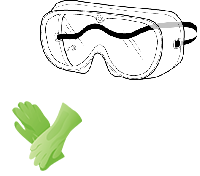Safety
Safety is a vital, if occasionally underappreciated, aspect of experimental work and as such we ensured that we followed the steps necessary to maintain a safe laboratory environment. Additionally following protocols correctly reduces the risk of mistakes and contamination of samples. All members of the team were briefed on general laboratory safety and on any specifics relating to our experiments before undertaking laboratory work.
- When moving about the laboratory you must walk, not run. Additionally you should not move in such a way that you would inhibit others in their work.
- Clothes must be suitable for laboratory work. This means no open toed shoes, loose/dangling jewelry or long hair that is not tied back.
- Labcoats must be worn and correctly fastened at all times when in the laboratory. When not in use they should be hung on a hook or on the back of a chair not thrown on the floor or put on a bench. Gloves should be worn when handling anything involving live samples or harmful chemicals.
- When an experiment requires it other safety equipment such as goggles should be worn.
- When moving samples and equipment outside the laboratory at least one hand must be non-gloved for opening doors and operating lifts.
- Do not chew pencils/pens or touch the area around your mouth when in the laboratory.
- When lit and not in use bunsen burners should be left on the yellow safety flame not the hot blue flame.
- You should not use your phone while in the laboratory to prevent contamination and risk of samples leaving laboratory.
- Spills should be dealt with straight away, if unsure ask someone for help. Accidents should be reported to the first aid team so they can be dealt with properly, and any medical attention can be given.
- Hands should be washed when leaving the lab to remove any bacteria that may be on them, particularly if work was undertaken without gloves.
- Before undertaking laboratory work, you must have read and signed the relevant COSHH form for the experiment.
- Used equipment must be put in the correct waste container. Tips must be put into one of the marked tip containers.
- Food must not be eaten in the laboratory.
- Follow safety instructions on equipment, ask if you are unsure how something works.
We consulted PhD advisors during more specialised experiments or when we were using specialised equipment such as a glovebox. This minimised the risk of exposure to bacteria, injury and damage to equipment.
- A fumehood was used for making the plates/gels that were used, we changed our gloves accordingly after using this area of the laboratory.
- Our electrochemical assays involved the use of methyl viologen, which is a toxic chemical. It is kept in the poisons cupboard away from the other standard reagents in the lab. Once it had been weighed out it was put in a screw top sample tube, this was then placed in a glove so that it could be easily located and safely moved to another room in the building.
- When using the glovebox we ensured that we removed watches and rings etc. since these could tear the gloves and make the glovebox unusable.
- The cells were earthed to a metal cage in the glovebox.
Our collaboration with university of Kent required us to take bacteria samples to their campus so that they could be imaged using atomic force microscopy. This meant that we had to consider the safety issues involved in taking bacteria into a public environment.
- We ensured that the bacteria we used were non-modified strains so that there was no risk of introducing non-natural strains that could spread.
- All samples were kept in sealed containers and were carried in a box that was sealed to prevent spillages or someone taking the top off easily.
As previously mentioned, in addition to the safety forms required for iGEM we read and signed the COSHH forms for the experiments that take place in the lab, including the ones that we may not be doing ourselves. These forms detail the safety protocols for the experiment and the action taken in the event of an accident.
Shewanella and E. coli were the bacteria types used in our project. These are both biosafety level one organisms and as such we followed the protocols relating handling them (see above).
Due to the highly immersive nature of the virtual reality software there were some safety precautions that needed to be in place when the headsets were used.
•Age limit - the headsets were not to be used by children under the age of 13
•People should be warned before using the headsets to stop immediately if they experience any dizziness or sickness
•People should be warned that using the headsets could trigger epilepsy and may affect them if they suffer from regular dizzy spells
•The program can be disorienting so people should have something to sit down on or something to hold onto when using the headsets


